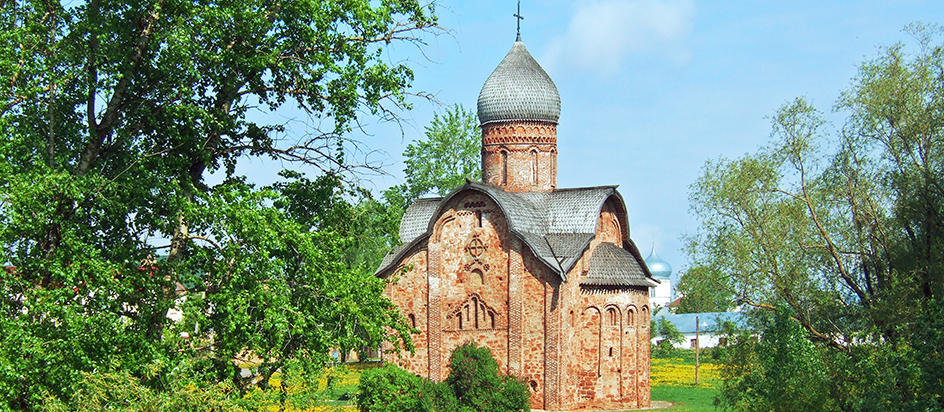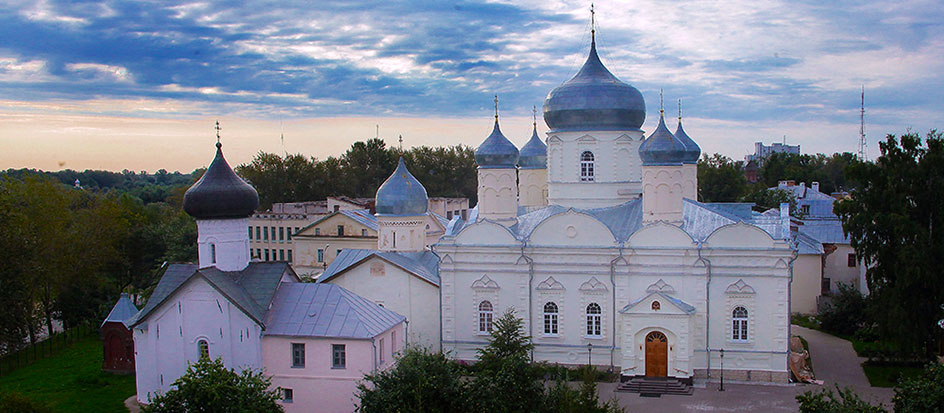The route goes along Velikaya Street and includes objects situated in the Nerevsky End - a district of the medieval Novgorod in the north of the Sophia Side. The small area of the Nerevsky End keeps the unique ensemble of monuments of Novgorod Republic, both architectual and archeological.
On July, 26, 1951 during the excavations run by the archeological expedition of the Moscow University and the Instiute of Archeology of the USSR Academy of Sciences led by A. V. Artsihovsky, the first birchbark letter was found. In memory of this event, a memorial sign «The first birchbark letter» (1, Velikaya Str.) became the starting point of the route. Also during the route you will see the Sts. Peter And Paul Church in Kozhevniki, the bust of Patriarch Alexiy II, the monument of Peter and Fevronia, the Church of the Holy Trinity, the Cloister of Holy Spirit and visit the Pokrovsky Cathedral at Zverin Convent, the Church of St. Simeon the God-Receiver at Zverin Convent, and the Arts Center where you can have a workshop on making birchbark toys.
In the XV c. the Nerevsky End, together with Slavenski End, was considered to be «great». Apparently, it was due to the successful colonization of Dvina lands by the boyars of the Neversky End mainly and the political activity of Isaak Andreevich Boretskiy - an activist for novgorodian liberty, a husband of the legendary Martha the Mayoress.
We offer you to get acquainted with the history of Velikiy Novgorod strolling along the ancient streets of the Nerevsky End.
.jpg)
1. A memorial sign «The first birchbark letter» was set up at the place where the first birchbark letter was found. The sculpture presents a 7 or 8 year old teenager, sitting on a wooden stool (a prototype of an old-russian piece of furniture). From this age started the education of teenagers in ancient Novgorod. This fact is supported by numerous findings of birchbark letters - textbooks, among which were found not only exercises (manuscripts and wax plates with the alphebet, writings of syllables with alternating vowels), but also children's practice in drawing and making inscriptions on birchbark (for example, so called «letters of Onfim»). At the foot of the sitting boy the fragments of birchbark are scattered which became a popular thing in novgorodian writing culture. Considering the boys age, a wooden toy «horsie» is put near a leg of the stool - it is a frequent finding in novgorodian cultural layer. Listen to the audio guide.
.jpg)
2. The Novgorod Drama Theatre n.a. F.M. Dostoyevsky starts its history from 1853, when due to a famous in the middle of the XIX c. entrepreneur Nikolai Ivanovich Ivanov in one of the merchats' houses, in a room converted into a theatre, regular commercial plays were performed during all season. Having rich past and carefully preserving its historical traditions the theatre now occupies confident positions in the modern cultural and spiritual life of the city and region.
.jpg)
3. The Cloister of Holy Spirit, XII c. - is one of the biggest and richest cloisters of Novgorod. First mentioned in chronicles as already existing in 1162. The first stone church of the Holy Spirit was built in 1357.
The Church of the Holy Trinity at Zverin Convent - is a pillarless three-storied high church with an elegant completion of facades, five deaf domes and rich brick decor. A highly artistic example of Russian architecture of the mid-XVIth century.

4. The Sts. Peter And Paul Church in Kozhevniki, 1406 is located outside the Earth City in the area that was called Kozhevniki, because leatherworkers once lived here. Since their work was associated with extremely unpleasant odors, leatherworkers lived outside the city limits. Built in 1406, the stone church is one of the most beautiful in the city. Initially, the monument looked the same as it is now. *Note! In winter (from October 1), the church is closed to the public.
.jpg)
5. Novgorod regional Arts centre is located in the historical part of Velikiy Novgorod on the territory of the historical and cultural landmark - the ensemble of the monastery of St. Nicholas the White and traces its history back to 1945.
.jpg)
6. The monument to Holy Peter and Fevronia. According to the legend Peter and Fevronia were the prince and princess of Murom who were revered in Russia as patrons of married life. Fevronia was a peasant woman and boyars were against the marrige of Peter and Fevronia, who didn't want to see as their prince a man who married a simple peasant woman. Peter and Fevronia preferred family life to reigning on the throne of Murom. They lived happily ever after and died in one day and one hour in 1228. Although they were buried separately, their bodies miraculously appeared in the same grave.

7. The Pokrovsky Cathedral at Zverin Convent - the monastery is called Pokrovsky by the main Church of the Protecting Veil of the Mother of God, Zverin - by the place that existed here in the 11th century - a menagerie, that is, defense lands for prince hunting.
.jpg)
8. The Church of St. Simeon the God-Receiver at Zverin Convent, 1467 - On the premises of the former Zverin Convent is situated now working Church of the Protecting Veil of the Mother of God, XIV c., and the Pokrovsky Monastery which was attached to it in 1901 and where the relics of reverend Sabbas of Vishera - a stylite and a miracle worker are kept.
.jpg)
9. The bust of Patriarch Alexiy II
10. A Monument to Novgorodian Militia of 1812 was erected in memory of a heroic act of militiamen who took part in military operations against the Napoleon army in the Patriotic War of 1812. The monument was re-created on the model of an old monument wich was built upon the project of an architect A.P. Brullov and diassembled after the Revolution.
.jpg)
11. The Sports Centre «Manezh». This building is more than 150 years old and it is a historical monument. In the XIX c. it was built as a center for gymnastics and became a place where the soldiers of Novgorod garrison had gymnastic trainings and parades. At the beginning of the XX c. the headquarters of revolutionary soldires were located there.
*You can also see:
.jpg)
*12. A sculpture An Electrician and a Cat. You can see a novgorodian electrician on the alley near the Polytechnical college of Yaroslav the Wise Novgorod State University. Novgorodians believe that if you take photo hugging a wooden pillar, you will get what you want.